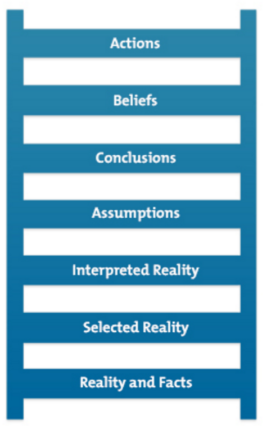You are having a difficult conversation with a developer during story boarding the product. You are at an impasse and you are not sure what to do. Do you retreat or do you go in full throttle and hope for the best? Are you jumping to conclusions, are they jumping to conclusions? Are you sure your reasoning is based on the facts? The ‘Ladder of Inference’ is a tool put together by psychologist Chris Argyris to help you understand the thinking steps taken that can lead you to jump to the wrong conclusion. It describes the steps that we climb to get from a fact to a decision often without realizing it. It can be used to help us in difficult situations and develop shared understanding.

At the bottom is Reality and Facts you climb up one step and you select your reality based on you prior experiences and beliefs. You then Interpret what that reality means and then make assumptions based on your interpretations. You are half way up nearly there, with your assumptions you go on to draw conclusions and develop beliefs which you use to take actions or make decisions. There you end up at the top, a bad conversation would mean you would stay at the top and not budge. What is worse we could skip steps as beliefs has a big impact on how we see reality and can make us miss the true facts.
You can use the ladder of inference to draw better conclusions or challenge other people’s conclusions based on true facts and reality. The process helps you to remain objective and, when working with or challenging others, reach a shared conclusion. The ladder can help if you find yourself asking the following questions.
- Is this the right conclusion?
- Why am I making these assumptions?
- Why do I think this is the right thing to do?
- Is this really based on all the facts?
- Why does he believe that?
To answer these questions firstly stop and consider your reasoning. Identify where you are on the ladder, are you:
- Selecting your reality or facts
- Interpreting what you have
- Making assumptions based on your interpretation
- Drawing conclusions
- Developing your beliefs
- Taking action or making decisions
Once you know where you are on the ladder slowly climb back down each step and on each step, ask yourself why?
- Why have I chosen this course of action? Was it well founded?
- Why did my beliefs lead to my taking this course?
- Why did I come to these conclusions? Are there others?
- Why am I assuming this? Am I right?
- Why did I interpret the facts or reality this way? Have I selected the right facts?
- Why did I choose these facts or reality? Are there others I should choose?
Once you have worked your way back down you will have a new sense of reasoning and a possible wider range of facts to make better assumptions with, you can now climb the ladder again.
The great thing about this tool is that I believe testers use this all the time in testing. When approaching a test, I look at the facts, data and the reality. I choose which data to use, I decide what the facts are which informs my reality. I make interpretations based on the data and the reality which inform assumptions and beliefs which may be pre-existing from other products or past knowledge. I then see a problem, but is it?
- Why do I believe this to be a problem?
- What were my beliefs at the time and why do I have them?
- What assumptions have I made and why?
- Did I interpret the facts correctly?
- Have I chosen good data is my reality correct?
By following these steps, I can verify my findings I can form a story for the team as to why I believe this to be a problem. I can take them on a journey about my thought process and how I got to my conclusions. A good report tells a story it includes an oracle and it informs the reader on what you believe the problem to be. I can take the developer or product owner up and down the ladder to verify the findings and to bring about a shared understanding of the problem.
I can also find that my findings are wrong that I have jumped to conclusions I missed a step on the ladder which has lead me to thinking this is a problem but because I have used the ladder to go over my thoughts I have found a problem within my test not the product. I can rectify it before making false claims.
This tool, skill can help you improve your conversations making them more productive and getting the team to a shared understanding faster. It can also help you produce better problem/observation reports and help you understand how you got to the conclusion.